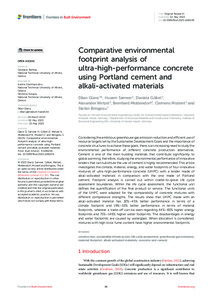Datum
2023-05-22Autor
Glanz, DilanSameer, HusamGöbel, DanielaWetzel, AlexanderMiddendorf, BernhardMostert, ClemensBringezu, StefanMetadata
Zur Langanzeige
Aufsatz

Comparative environmental footprint analysis of ultra-high-performance concrete using Portland cement and alkali-activated materials
Zusammenfassung
Considering the ambitious greenhouse gas emission reduction and efficient use of resource targets set by the Sustainable Development Goals and the importance of concrete structures to achieve these goals, there is an increasing need to study the environmental performance of different concrete production alternatives. Cement is one of the main building materials that contribute significantly to global warming; therefore, studying the environmental performance of innovative binders that can substitute the use of cement is highly recommended. This article investigates the climate, material, energy, and water footprints of four innovative mixtures of ultra-high-performance concrete (UHPC) with a binder made of alkali-activated materials in comparison with the one made of Portland cement. Footprint analysis is carried out within cradle-to-grave life cycle assessment boundaries. Within the life cycle assessment, the functional unit defines the quantification of the final product or service. The functional units of the UHPC were adapted for the comparability of concrete mixtures with different compressive strengths. The results show that UHPC made with an alkali-activated material has 32%–45% better performance in terms of a climate footprint and 19%–33% better performance in terms of material footprints, whereas a trade-off can be seen regarding 44%–83% higher energy footprints and 75%–146% higher water footprints. The disadvantages in energy and water footprints are caused by waterglass. When allocation is considered, mixtures with high silica fume content have higher environmental footprints.
Zitierform
In: Frontiers in Built Environment Volume 9 (2023-05-22) eissn:2297-3362Förderhinweis
Gefördert durch den Publikationsfonds der Universität KasselZitieren
@article{doi:10.17170/kobra-202306138210,
author={Glanz, Dilan and Sameer, Husam and Göbel, Daniela and Wetzel, Alexander and Middendorf, Bernhard and Mostert, Clemens and Bringezu, Stefan},
title={Comparative environmental footprint analysis of ultra-high-performance concrete using Portland cement and alkali-activated materials},
journal={Frontiers in Built Environment},
year={2023}
}
0500 Oax
0501 Text $btxt$2rdacontent
0502 Computermedien $bc$2rdacarrier
1100 2023$n2023
1500 1/eng
2050 ##0##http://hdl.handle.net/123456789/14815
3000 Glanz, Dilan
3010 Sameer, Husam
3010 Göbel, Daniela
3010 Wetzel, Alexander
3010 Middendorf, Bernhard
3010 Mostert, Clemens
3010 Bringezu, Stefan
4000 Comparative environmental footprint analysis of ultra-high-performance concrete using Portland cement and alkali-activated materials / Glanz, Dilan
4030
4060 Online-Ressource
4085 ##0##=u http://nbn-resolving.de/http://hdl.handle.net/123456789/14815=x R
4204 \$dAufsatz
4170
5550 {{Portlandzement}}
5550 {{Ökologischer Fußabdruck}}
5550 {{Ultrahochfester Beton}}
7136 ##0##http://hdl.handle.net/123456789/14815
<resource xsi:schemaLocation="http://datacite.org/schema/kernel-2.2 http://schema.datacite.org/meta/kernel-2.2/metadata.xsd"> 2023-06-13T11:55:15Z 2023-06-13T11:55:15Z 2023-05-22 doi:10.17170/kobra-202306138210 http://hdl.handle.net/123456789/14815 Gefördert durch den Publikationsfonds der Universität Kassel eng Namensnennung 4.0 International http://creativecommons.org/licenses/by/4.0/ 620 Comparative environmental footprint analysis of ultra-high-performance concrete using Portland cement and alkali-activated materials Aufsatz Considering the ambitious greenhouse gas emission reduction and efficient use of resource targets set by the Sustainable Development Goals and the importance of concrete structures to achieve these goals, there is an increasing need to study the environmental performance of different concrete production alternatives. Cement is one of the main building materials that contribute significantly to global warming; therefore, studying the environmental performance of innovative binders that can substitute the use of cement is highly recommended. This article investigates the climate, material, energy, and water footprints of four innovative mixtures of ultra-high-performance concrete (UHPC) with a binder made of alkali-activated materials in comparison with the one made of Portland cement. Footprint analysis is carried out within cradle-to-grave life cycle assessment boundaries. Within the life cycle assessment, the functional unit defines the quantification of the final product or service. The functional units of the UHPC were adapted for the comparability of concrete mixtures with different compressive strengths. The results show that UHPC made with an alkali-activated material has 32%–45% better performance in terms of a climate footprint and 19%–33% better performance in terms of material footprints, whereas a trade-off can be seen regarding 44%–83% higher energy footprints and 75%–146% higher water footprints. The disadvantages in energy and water footprints are caused by waterglass. When allocation is considered, mixtures with high silica fume content have higher environmental footprints. open access Glanz, Dilan Sameer, Husam Göbel, Daniela Wetzel, Alexander Middendorf, Bernhard Mostert, Clemens Bringezu, Stefan 11 Seiten doi:10.3389/fbuil.2023.1196246 Portlandzement Ökologischer Fußabdruck Ultrahochfester Beton publishedVersion eissn:2297-3362 Frontiers in Built Environment Volume 9 false 1196246 </resource>
Die folgenden Lizenzbestimmungen sind mit dieser Ressource verbunden:


